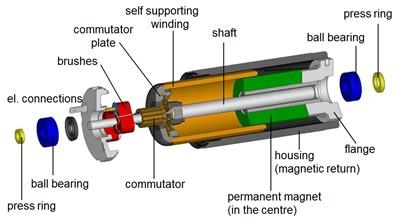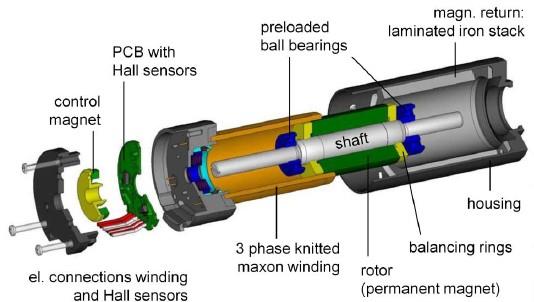- Required output speed/torque
- Available power supply
- Service life
- External conditions
- Temperature
- Humidity
- Dimensional capacity
Once these factors have been considered, the answer will be clear as to whether a brushed DC motor is suitable, or a brushless DC motor. The internal construction differs between the two and each comes with its own advantages and disadvantages.
Brushed motors from Maxon come with two options, one with Graphite Brushes and one with Precious Metal Brushes. The brushes make up the commutation system, as they make contact with the commutator bars when the rotor rotates, allowing the motor to achieve continuous motion and maintain the required torque.

Brushless motors have three phases, meaning they cannot be operated directly with a DC power supply or battery. The voltage has to be supplied in pulses to each phase creating a sequence which allows the motor to rotate in a constant manner. In order to achieve this, the positioning of the rotor is required, which is usually provided by the integrated hall sensors. The PCB at the back of the motor has three hall sensors mounted to it, each placed at an equal distance of 120°, and they detect the magnetic poles of the control magnet thus allowing the motor to be operated.

There are several reasons to opt for a brushless design as opposed to brushed, one of the main reasons being the service life. As the brushes in a brushed motor makes contact with the commutator during operation, it eventually leads to wear of the brushes which essentially reduces performance and service life. When considering the brushless design, the main factor which limits service life is the bearings which retain the shaft. Brushed motors on average achieve a service life of 1000-3000 hours whereas brushless motors should be able to achieve 20000 hours providing they are operated within their specification.
The output speed is also a key factor when choosing a brushed or brushless motor. Brushed motors can achieve up to approximately 18000 rpm (depending on brushes and bearings used) however brushless motors can achieve a continuous output speed of 120000 rpm (ECX range). The speed is also a result of the commutation system used.
The external conditions also play a huge part in determining which choice of motor to select. If, for example, the motor was to be operated in a vacuum, a modified brushless motor would be the first choice or a brushed motor with Precious Metal Brushes. With graphite brushes, oxygen and a certain level of humidity are required to form a sufficient patina layer on the commutator surface. This layer is crucial for creating an electrical contact as well as a low level of friction. In a vacuum application, a no patina layer will form. As for precious metal brushes, the brush lubricant would not be present as it would be removed as a modification, the reason being it would eventually evaporate in a vacuum application, this results in a limited service life.
Other advantages of using brushless motors are that there is no commutator arcing, and there is no brush fire which would contribute to a reduction in service life.
Using a brushless motor does come with disadvantages, the main one being that a controller is required in order to supply a voltage sequence between the three phases. Adding a controller to the system results in an increase in cost, and from an engineering point of view, results in more dimensional space being required to account for the controller as well as the relevant cables. The EC Flat range offers some versions with integrated 1Q speed controllers, which allow basic control of output speed within a compact solution.
With the key comparisons in mind, the choice between a brushed or brushless motor should be fairly clear, based on the specific application. Both options come with great advantages and can be used in various applications, offering a high level of performance, whilst providing a high service life.











